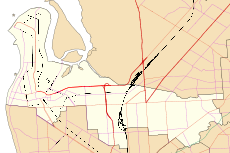Dudley Park, is a suburb of Adelaide, South Australia, located approximately 3 kilometres north-west of the CBD.[6] The suburb is bordered by Regency Road (north), Simpson Avenue (south), the Adelaide-Gawler railway line (east), and a line directly north–south from the Harrison Road-Simpson Avenue intersection to Regency Road (west).
| Dudley Park Adelaide, South Australia | |||||||||||||||
|---|---|---|---|---|---|---|---|---|---|---|---|---|---|---|---|
 Dudley Park Railway Station | |||||||||||||||
| Coordinates | 34°52′48″S 138°34′48″E / 34.880°S 138.580°E | ||||||||||||||
| Population | 670 (SAL 2021)[1] | ||||||||||||||
| Established | 1909[2] | ||||||||||||||
| Postcode(s) | 5008[3] | ||||||||||||||
| Location | 3 km (2 mi) north of Adelaide city centre | ||||||||||||||
| LGA(s) | City of Port Adelaide Enfield | ||||||||||||||
| State electorate(s) | Croydon[4] | ||||||||||||||
| Federal division(s) | Adelaide[5] | ||||||||||||||
| |||||||||||||||
The Dudley Park Cemetery is located within the suburb at the corner of Simpson Avenue and Exeter Terrace.
Two railway stations border the suburb, Islington railway station and Dudley Park railway station.
History
editBy the turn of the twentieth century, the Dudley Park area was known as Islington,[7] a name preserved in the present-day Islington railway station and also used for the Islington sewage farm (now Regency Park) from 1881 until 1966.
In October 1909, the Dudley Park subdivision was created and named after William Humble Ward, 2nd Earl of Dudley who was the Governor-General of Australia from 1908 to 1911 and had visited South Australia earlier that year.[2][3]
In 1940, a new factory was established by Becker Pty. Ltd. to manufacture caffeine, theobromine and other drugs on a 40 acres (16 ha) site on Pym Street in Dudley Park. This had become necessary as the major global source for caffeine had been the Netherlands, which had been occupied by Germany early in World War II.[8] The primary feedstock for caffeine production was cocoa waste imported from other states of Australia.[9] As the factory was being established, the state government assisted with a new road and railway crossing, and extending the metropolitan sewerage to the area.[10] An explosion at the chemical works in 1942 resulted in the death of two workers.[11] The most well-known product of this factory would have been Bex Powders. The facade of the factory and administration building have local heritage protection.[12]
Government
editDudley Park is located within the local government area of the Port Adelaide Enfield, the state Electoral District of Croydon and the federal Division of Adelaide[5][3][4]
References
edit- ^ Australian Bureau of Statistics (28 June 2022). "Dudley Park (SA) (suburb and locality)". Australian Census 2021 QuickStats. Retrieved 28 June 2022.
- ^ a b Manning, G. "Place Names of South Australia – D, Dudley Park". State Library of South Australia. Retrieved 3 December 2015.
- ^ a b c "Search result for "Dudley Park" (SUB) (Record id no. SA0020937)". Land Services, Department of Planning, Transport and Infrastructure. Archived from the original on 12 October 2016. Retrieved 3 December 2015.
- ^ a b "District of Croydon map". ELECTORAL COMMISSION SA. 2014. Retrieved 3 December 2015.
- ^ a b "Federal Electoral Division of Adelaide" (PDF). Australian Electorate Commission. 16 December 2011. Retrieved 3 December 2015.
- ^ 2003 Adelaide Street Directory, 41st Edition. UBD (A Division of Universal Press Pty Ltd). 2003. ISBN 0-7319-1441-4.
- ^ Adelaide – Map 8 (Map). c. 1945. Archived from the original on 1 April 2016. Retrieved 16 December 2015.
- ^ "NEW INDUSTRY IN ADELAIDE". The Advertiser. Vol. LXXXVII, no. 26765. Adelaide. 15 July 1944. p. 4. Retrieved 26 January 2018 – via National Library of Australia.
- ^ "NEW CHEMICAL WORKS TO PRODUCE SOON". The News. Vol. XXXV, no. 5, 364. Adelaide. 3 October 1940. p. 12. Retrieved 25 January 2018 – via National Library of Australia.
- ^ "Visiting Businessman Says.. Important Drugs to Be Made in Australia". Sunday Times (Perth). No. 2243. Western Australia. 19 January 1941. p. 3. Retrieved 25 January 2018 – via National Library of Australia.
- ^ "Funeral of Explosion Victims". The News. Vol. 38, no. 5, 843. Adelaide. 20 April 1942. p. 6. Retrieved 26 January 2018 – via National Library of Australia.
- ^ "Factory & Administration building (formerly Beckers)". SA Heritage Places Database. Government of South Australia. 4 May 2000. Retrieved 19 January 2019.
